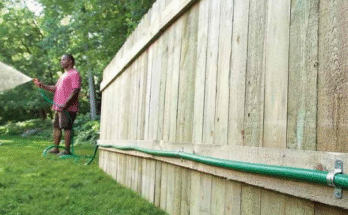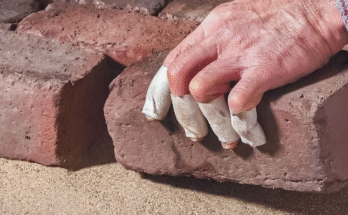This year, why not give your outdoor furniture a fresh new look with a coat of paint? It’s an affordable, DIY-friendly project that can instantly revitalize your outdoor space.
I remember the first time I painted my wood patio chairs—I made every rookie mistake in the book. I used spray paint on a windy day, skipped essential prep work and stopped after just one coat. While the furniture looked better initially, the paint didn’t last long, and I even found overspray on my house siding! That experience taught me there’s much more to painting outdoor furniture than just spraying on some color.
To avoid my mistakes and other common pitfalls, follow these tips from Shayne Pancione of Pancione Painting Plus and Rachel Otto of Fleury Lumber.
1 / 17

Kinga Krzeminska/Getty Images
Evaluate Your Furniture
Take a good look at your furniture and decide if painting or staining is even worth it. Look and feel for soft or rotted spots on wood furniture, inspect plastic furniture for cracks and check metal furniture for excessive rust. You can certainly fix a wobbly chair or repair scratches and dents, but if a chair is severely rotted or the plastic leg of a table is cracked and falling apart, it may be time for new furniture.
2 / 17

MDV Edwards/Getty Images
Remove Rust
With the right prep work and products, you can paint over rust on metal outdoor furniture. “When dealing with rust, the removal process depends on its severity,” Pancione says. We use various tools like wire brushes, sandpaper and grinding wheels for the job.” You’ll want to remove as much rust as possible, preferably down to bare metal, then prime with an oil-based primer.
3 / 17

tumsasedgars/Getty Images
Remove Loose Paint
If you’re painting or staining wood or metal furniture, remove any loose or peeling paint before applying a new coat. Using a wire brush or paint scraper, gently scrape any loose paint. “If you can get it down to bare wood or metal, this will really help with adhesion,” Otto says. Then use 120 grit sandpaper to smooth the surface and sand down any rough edges. For metal furniture, use steel wool or a sanding sponge.
4 / 17

Katarina Molnarova/Getty Images
Clean the Furniture Thoroughly
Exposed to the elements throughout the season, outdoor furniture can get surprisingly dirty. Use soapy water and a sponge to scrub furniture, then rinse thoroughly with a garden hose and let dry. For mold and mildew stains on wood furniture, use a 1:1 ratio of white vinegar and water if soap and water aren’t effective. “Make sure there’s no pollen, dust or grease residue on your furniture before painting,” Otto says.
5 / 17

Ivanna Bond/Getty Images
Consider Primer
Whether you’re using spray paint or brush-on paint, consider applying a coat of primer before you apply the color. No matter what the material, primer will create a strong bond between the paint and the furniture surface. For wood furniture, a coat of primer will seal wood pores for a smoother finish. Use an oil-based, rust-inhibiting primer on metal furniture or a rust converter for metal furniture with existing rust.
6 / 17

StefaNikolic/Getty Images
Spray Paint Patio Furniture
If you’re using spray paint for outdoor furniture, you can skip the primer. Conventional spray paints don’t need primer and work best for painting outdoor furniture made of wicker and metal. If you’re looking to paint plastic outdoor furniture, look for spray paint formulated to adhere to plastic. For wood furniture, consider using a paint sprayer to apply latex paint for a smooth finish.
7 / 17

Blanchi Costela/Getty Images
Use the Right Tools
Using the right painting tools for the right project can prevent serious headaches. When painting smaller, more intricate pieces of furniture, smaller brushes and rollers are better. A paint roller may be the best choice if you need to cover a large area, like a tabletop. For large furniture sets, using a paint sprayer is more economical than using canned spray paint.
8 / 17

jirkaejc/Getty Images
Use the Right Paint or Stain
Use exterior paint formulated for the furniture material. “If it’s plastic or metal, use spray paint for better adhesion, but for wood Adirondack chairs, use a brush-on latex paint,” Otto says. If you prefer to stain wood furniture, consider a solid body stain for the best durability. Some wood furniture, like teak, does best with an oil treatment each season and does not need to be stained or painted.
9 / 17

kobeza/Getty Images
Choose a Finish
If you’re painting wood or metal, it doesn’t really matter which finish you choose—whether it’s gloss, satin or eggshell—as long as your paint is made for outside use. However, glossy finishes hold up better outdoors and are more washable. “It really comes down to personal preference,” Otto says. “It just depends on how glossy you want it to be.”
10 / 17

ArtMarie/Getty Images
Consider Climate
Depending on where you live, you may need more protection from the elements when painting outdoor furniture. In very warm, sunny climates, consider using paint with ultraviolet protection to slow color fading and improve durability. If you live in a rainy part of the country, paint metal outdoor furniture with rust-inhibiting paint and wood furniture with mildew-resistant paint.
11 / 17

PhanuwatNandee/Getty Images
Apply Multiple Thin Coats
A common rule of thumb is to apply at least two coats of paint or stain, although be sure to consider any additional instructions on the can. Don’t be tempted to apply thick coats to get the job done faster. Instead, apply thinner coats because they will dry faster and more consistently. This is especially true when using spray paint. A thick coat of spray paint will quickly run or sag, while multiple thin coats will give you the best results.
12 / 17

Sladic/Getty Images
Choose a Color
Your options are virtually endless when it comes to choosing a paint color. One easy way to choose a color is to go with something that compliments your home’s exterior. If you’re unsure about paint color combinations, use the color wheel method: find a color that you like and then pick the corresponding color directly across from it on the wheel. Also, consider how sunny your outdoor area is, as “darker colors will get hotter than lighter colors,” Otto says.
13 / 17

ArtMarie/Getty Images
Make Minor Repairs
If your outdoor furniture has minor damaged areas, these can be repaired before painting. For small areas of rotted wood, scrape and sand away any soft fibers until you’re down to hardwood. Then, apply a wood restorer product, which will stop further rotting and harden any remaining softwood fibers. Rusted holes in metal furniture can also be repaired. “We apply fillers such as Bondo to restore the surface,” Pancione says, then sand the surface smooth when it hardens.
14 / 17

FAMILY HANDYMAN
Remove Hardware
Before you get started painting your outdoor furniture, remove the hardware (if possible) from the furniture. This will allow for a smoother, more professional-looking finish. Painting around hardware is difficult, and you will likely get some on the hardware during the process. This is also a good opportunity to clean hardware or paint it if you choose. If you get paint on the hardware, you can remove the paint with a hot water bath.
15 / 17

blackCAT/Getty Images
Avoid a Mess
If you want to paint without making a mess, have all your supplies ready to go before you get started. Cover the area with drop cloths so you don’t get paint on the patio, deck or garage floor. Wear protective gloves and work methodically to avoid creating a mess. Don’t oversaturate your brush with paint, and if you are using spray paint, protect any nearby areas from overspray.
16 / 17

Anchiy/Getty Images
Consider the Weather
Ideally, paint outdoor furniture on a day with mild temperatures, low humidity and little wind. Avoid painting in direct sun, as it can cause the paint to dry too quickly, reducing its durability. Check the forecast for rain and follow the manufacturer’s temperature recommendations. If it’s too hot or cold outside, move the project to a garage or basement and provide adequate ventilation. Plan to spray paint on windless days to avoid wasting paint and creating excessive overspray.
17 / 17



